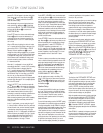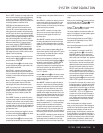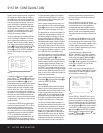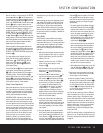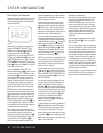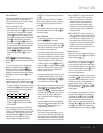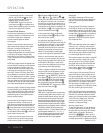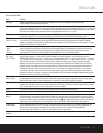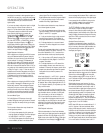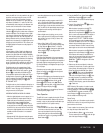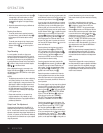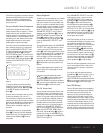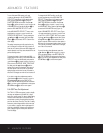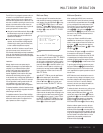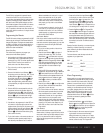
OPERATION
28 OPERATION
should also be connected to their appropriate inputs on
the AVR 330 rear panel (e.g., connect the analog stereo
audio output from a DVD to the
DVD Audio Inputs
on the rear panel when you connect the source’s
digital outputs).
If you have not already configured an input for a digital
source using the on-screen menus as shown on
pages 18–19, first select the input using the remote
or front-panel controls, as outlined in this manual.
Next, select the digital source by pressing the
Digital Select Button q# and then using the
⁄
/
¤
Buttons n on the remote or the
‹
/
›
Selector Buttons ) on the front panel to
choose
any of the
OPTICAL or COAXIAL
inputs, as
they appear in the
Upper Display Line ˜ or on-
screen display. When the digital source is playing, the
AVR 330 will automatically detect which type of digital
data stream is being decoded and display that infor-
mation in the
Upper Display Line ˜.
Digital Bitstream Indications
When a digital source is playing, the AVR 330 senses
the type of bitstream data that is present. Using this
information, the correct surround mode will automati-
cally be selected. For example, DTS bitstreams will
cause the unit to switch to DTS decoding, and Dolby
Digital bitstreams will enable Dolby Digital decoding.
When the unit senses PCM data from CDs or LDs, you
may select any of the standard surround modes, such
as Dolby Pro Logic II or Logic 7. Since the range of
available surround modes is dependent on the type of
digital data that is present, the AVR 330 uses a variety
of indicators to let you know what type of signal is
present. This will help you to understand the choice
of modes.
When a digital source is playing, the AVR 330 will dis-
play a variety of messages to indicate the type of bit-
stream being received. These messages will appear
shortly after an input or surround mode is changed,
and they will remain in the
Lower Display Line ¯
for about five seconds before that portion of the dis-
play returns to the normal surround mode indication.
Surround Mode Types
For Dolby Digital and DTS sources, a three-digit
indication will appear, showing the number of channels
present in the data. An example of this type of display
is 3/2/.1.
The first number indicates how many discrete front-
channel signals are present.
• A “3” tells you that separate front left, center and
front right signals are available. This will be displayed
for Dolby Digital 5.1 and DTS 5.1 programs.
• A “2” tells you that separate front left and right sig-
nals are available, but there is no discrete center
channel signal. This will be displayed for Dolby
Digital bitstreams that have stereo program material.
• A “1” tells you that there is only a mono channel
available in the Dolby Digital bitstream.
The middle number indicates how many discrete sur-
round channel signals are present.
• A “2” tells you that separate surround left and right
signals are available. This will be displayed for Dolby
Digital 5.1 and DTS 5.1 programs.
• A “1” tells you that there is only a single, surround-
encoded surround channel. This will appear for
Dolby Digital bitstreams that have matrix encoding.
• A “0” indicates that there is no surround channel
information. This will be displayed for two-channel
stereo programs.
The last number indicates whether there is a discrete
low-frequency effects (LFE) channel. This is the “.1” in
the common abbreviation of “5.1” sound and it is a
special channel that contains only bass frequencies.
• A “.1” tells you that an LFE channel is present. This
will be displayed for Dolby Digital 5.1 and DTS 5.1
programs, as available.
• A “0” indicates that there is no LFE channel infor-
mation available. However, even when there is no
dedicated LFE channel, low-frequency sound will be
present at the subwoofer output when the speaker
configuration is set to show the presence of a
subwoofer.
When Dolby Digital 3/2/.1 or DTS 3/2/.1 signals are
being played, the AVR will automatically switch to the
proper surround mode, and no other processing may
be selected. When a Dolby Digital signal with a 3/1/0
or 2/0/0 signal is detected, you may select any of the
Dolby surround modes.
It is always a good idea to check the readout for the
channel data to make certain that it matches the audio
logo information shown on the back of a DVD pack-
age. In some cases, you will see an indication for
“2/0/0” even when the disc contains a full 5.1, or
3/2/.1, signal. When this happens, check the audio
output settings for your DVD player or the audio menu
selections for the specific disc being played to make
certain that the player is sending the correct signal
to the AVR.
PCM Playback Indications
PCM is the abbreviation for Pulse Code Modulation,
which is the type of digital signal used for standard CD
playback, and other non-Dolby Digital and non-DTS
digital sources such as Mini-Disc. When a PCM signal
is detected, the
Lower Display Line ¯ will briefly
show a message with the letters PCM, in addition to a
readout of the sampling frequency of the digital signal.
In most cases, this will be
48kHz, though in the
case of specially mastered, high-resolution audio
discs, you will see a
96kHz indication.
The
PCM 48kHz indication will also appear
when modes or inputs are changed for analog
sources. In those cases, the system is telling you the
sampling frequency used internally at the output of the
analog-to-digital converters that change the incoming
signal from a VCR, a tape deck, the tuner or another
analog source to digital.
Speaker/Channel Indicators
In addition to the bitstream indicators, the AVR 330
features a set of unique channel-input indicators that
tell you how many channels of digital information are
being received and/or whether the digital signal is
interrupted (see Figure 9).
Figure 9
These indicators are the L/C/R/LFE/SL/SR/SBL/SBR
letters that are inside the center boxes of the
Speaker/
Channel Input Indicators
ˆ on the front panel.
When a standard analog signal is in use, only the “L”
and “R” indicators will light, as
analog signals have only
left and right channels.
Digital signals, however, may have two, five, six or
seven channels, depending on the program material,
the method of transmission and the way in which it
was encoded. When a digital signal is playing, the let-
ters in these indicators will light in response to the
specific signal being received. It is important to note
that although Dolby Digital, for example, is referred
to as a “5.1” system, not all Dolby Digital DVDs or
programs are encoded for 5.1. Thus, it is sometimes
normal for a DVD with a Dolby Digital soundtrack to
trigger only the “L” and “R” indicators.
NOTE: Many DVD discs are recorded with both “5.1”
and “2.0” versions of the same soundtrack. When
playing a DVD, always be certain to check the type of
material on the disc. Most discs show this information
in the form of a listing or icon on the back of the disc
jacket. When a disc does offer multiple soundtrack
choices, you may have to make some adjustments to
your DVD player (usually with the “Audio Select” button
or in a menu screen on the disc) to send a full 5.1
33



